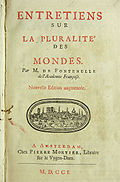
Conversations on the Plurality of Worlds
Encyclopedia

Popular science
Popular science, sometimes called literature of science, is interpretation of science intended for a general audience. While science journalism focuses on recent scientific developments, popular science is broad-ranging, often written by scientists as well as journalists, and is presented in many...
book by French author Bernard le Bovier de Fontenelle
Bernard le Bovier de Fontenelle
Bernard Le Bovier de Fontenelle , also called Bernard Le Bouyer de Fontenelle, was a French author.Fontenelle was born in Rouen, France and died in Paris just one month before his 100th birthday. His mother was the sister of great French dramatists Pierre and Thomas Corneille...
, published in 1686. It offered an explanation of the heliocentric model of the Universe, suggested by Nicolaus Copernicus
Nicolaus Copernicus
Nicolaus Copernicus was a Renaissance astronomer and the first person to formulate a comprehensive heliocentric cosmology which displaced the Earth from the center of the universe....
in his 1543 work De revolutionibus orbium coelestium
De revolutionibus orbium coelestium
De revolutionibus orbium coelestium is the seminal work on the heliocentric theory of the Renaissance astronomer Nicolaus Copernicus...
. The book is Fontenelle's most famous work and is considered to be one of the first major works of the Age of Enlightenment
Age of Enlightenment
The Age of Enlightenment was an elite cultural movement of intellectuals in 18th century Europe that sought to mobilize the power of reason in order to reform society and advance knowledge. It promoted intellectual interchange and opposed intolerance and abuses in church and state...
.
Background
Unlike many scientific works of its time, Conversations on the Plurality of Worlds was written not in LatinLatin
Latin is an Italic language originally spoken in Latium and Ancient Rome. It, along with most European languages, is a descendant of the ancient Proto-Indo-European language. Although it is considered a dead language, a number of scholars and members of the Christian clergy speak it fluently, and...
, but in French and is notable as one of the first books to attempt an explanation of scientific theories
Science
Science is a systematic enterprise that builds and organizes knowledge in the form of testable explanations and predictions about the universe...
in popular
Popular science
Popular science, sometimes called literature of science, is interpretation of science intended for a general audience. While science journalism focuses on recent scientific developments, popular science is broad-ranging, often written by scientists as well as journalists, and is presented in many...
language. In the preface, Fontenelle addresses female readers and suggests that the offered explanation should be easily understood even by those without scientific knowledge. This move has been praised by some of modern feminist critics as admitting women's intelligence in scientific matters.
Plot summary
The book itself is presented as a series of conversations between a gallant philosopher and a marquiseMarquise
A marquise is a French noblewoman ranking above a countess and below a duchess, and is usually the wife of a marquis. The British equivalent is a marchioness and the Spanish equivalent is a marquesa....
, who walk in the latter's garden at night and gaze at star
Star
A star is a massive, luminous sphere of plasma held together by gravity. At the end of its lifetime, a star can also contain a proportion of degenerate matter. The nearest star to Earth is the Sun, which is the source of most of the energy on Earth...
s. The philosopher explains the heliocentric model and also muses on the possibility of extraterrestrial life
Extraterrestrial life
Extraterrestrial life is defined as life that does not originate from Earth...
. At the same time, Fontenelle avoided challenging the Catholic Church and its view of the world.
Translations
The first English translation was compounded by John Glanvill in 1687, followed by another translation by Aphra BehnAphra Behn
Aphra Behn was a prolific dramatist of the English Restoration and was one of the first English professional female writers. Her writing contributed to the amatory fiction genre of British literature.-Early life:...
in 1688, under the title A Discovery of New Worlds. Antiokh Kantemir translated it into Russian
Russian language
Russian is a Slavic language used primarily in Russia, Belarus, Uzbekistan, Kazakhstan, Tajikistan and Kyrgyzstan. It is an unofficial but widely spoken language in Ukraine, Moldova, Latvia, Turkmenistan and Estonia and, to a lesser extent, the other countries that were once constituent republics...
in 1730, although the translation was only published in a censored
Censorship
thumb|[[Book burning]] following the [[1973 Chilean coup d'état|1973 coup]] that installed the [[Military government of Chile |Pinochet regime]] in Chile...
edition in 1740, due to objections from Russian Orthodox Church
Russian Orthodox Church
The Russian Orthodox Church or, alternatively, the Moscow Patriarchate The ROC is often said to be the largest of the Eastern Orthodox churches in the world; including all the autocephalous churches under its umbrella, its adherents number over 150 million worldwide—about half of the 300 million...
.
Reception
The book was very well received both in France and elsewhere, and was regularly published. In 1691, Fontenelle was elected to Académie françaiseAcadémie française
L'Académie française , also called the French Academy, is the pre-eminent French learned body on matters pertaining to the French language. The Académie was officially established in 1635 by Cardinal Richelieu, the chief minister to King Louis XIII. Suppressed in 1793 during the French Revolution,...
.
External links
- Full text of 1800 edition at Google Books (in French)
- Full text of 1803 edition at Google Books (in English)
- Full text of 1803 edition Digitized by Google, Free Download at OpenLibrary (in English)

